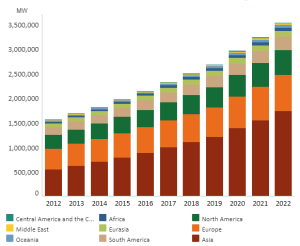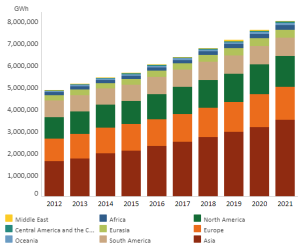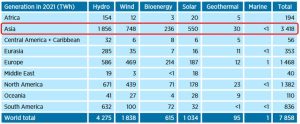Asia-Pacific
Asia and the Pacific region collectively comprise a large and dynamic region with 4.7 billion people living in a range of countries from the world’s largest energy consumer (China) to small island economies. This region accounts for more than half of global energy consumption, with 85% of this consumption coming from fossil fuels. Even so, about 10% of the people in this area lack access to electricity and rely on traditional biomass consumption (such as wood combustion) for cooking and heating. Demand for energy is rising due to urbanization and industrialization, but many opportunities exist to avoid carbon-based energy.[1]
Renewable Energy Installed Capacity
Asia accounted for 60% of new renewable energy capacity in 2021 increasing by 154.7 GW to 1.46 TW (48% of global total).[2] The top five Asian countries with renewable energy installed capacity include China with the largest percentage, followed by India, Japan, Vietnam and the Republic of Korea. [3]
Trends in Renewable Energy by Region, Installed Capacity

Source: IRENA, 2023[4]
Renewable Energy Electricity Generation
Electricity generation in Asia from renewable energy sources reached 3,480,502 gigawatts per hour (GWh) in 2021. The top five Asian countries creating electricity via renewable energy include China with the largest percentage, followed by India, Japan, Vietnam, and Indonesia.[5]
Trends in Renewable Energy by Region, Electricity Generation

Source: IRENA, 2023[6]
What Types of Renewable Energy are Currently Used in Asia?
The following table outlines 2021 Asian renewable power generation statistics. Renewable energy technologies currently in use include hydropower, wind, bioenergy, solar, geothermal, and marine.

Source: International Renewable Energy Agency, 2023[7]
Asia Super Grid
The Asia Super Grid (ASG) is a joint effort to build a network to connect the electric power systems of Asian countries, enabling benefits through renewable energy (e. g. wind, solar and hydropower) exchange.[8] The ASG, which would be a massive system of interconnected electricity grids, is being backed by China, Japan, South Korea, Russia, Mongolia, and utilities including the State Grid Corporation of China, Korea Electric Power Corporation, Rossetti (Russia), and Newcom (Mongolia).[9] In July 2019, the Asia International Grid Connection Group released a third report presenting the latest situation regarding interconnectors in Northeast Asia, and the situation in the United Kingdom and Spain, which are geographically disadvantaged for international grid connections. The benefits of interconnections for Japan were analyzed qualitatively, and analyses of energy security issues related to interconnectors were also examined.[10]
Asia-Pacific Economic Cooperation (APEC) Energy Working Group
The Asia-Pacific Economic Cooperation (APEC) region accounts for approximately 60 percent of world energy demand and includes four of the world's five largest energy users (China; Japan; Russia; and the United States). The APEC Energy Working Group (EWG), established in 1990, is comprised of policy officials and subject matter experts from APEC Member Economies, who work with stakeholders in academia, private industry, and regional and international organizations to promote energy efficiency.[11] The EWG aims to strengthen regional and local energy security and resilience; lower carbon energy supply and use; promote the diversification of fuels and sources and train an energy workforce. EWG is working towards APEC’s target of reducing aggregate energy intensity by 45 percent from 2005 levels by 2035 through collaboration on analysis of available energy efficient technologies, energy efficiency standard harmonization, and peer review on energy efficiency.[12] The group’s work is guided by its Strategic Plan for 2019–2023.[13]
According to the APEC Energy Demand and Supply Outlook (8th Edition), the final energy demand of APEC economies is only forecast to grow at a modest 14% from 2018-2050. And fossil fuels fall from 70% of end-use energy to just over 60% by 2050. Electrification is forecast to reach 29% of energy demand. The report also shows that APEC will reach its goal of reducing energy intensity by 45% by 2034, one year ahead of the original schedule. The second shared goal is to double the share of modern renewables in the energy mix by 2030 and APEC is expected to meet the goal by 2026.[14]
Updated by Erin George, December 2023

Comments are closed.